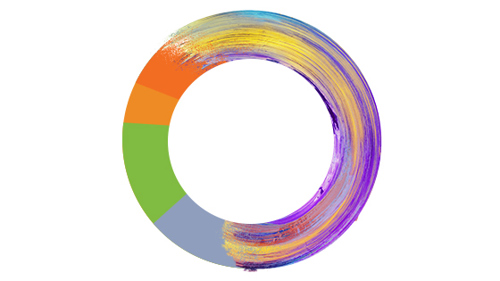The Responsibility That Comes with Acting Creatively and Strategically During a Pandemic
In a time when brands need to be nimble enough to know how to respond to a health crisis that evolves hour by hour, can a “sweet spot” for marketing and advertising efforts even exist?
We all have our senses tilted toward the brands that are sensibly communicating amidst this global pandemic—and even more so toward the brands that aren’t. Who reserves the right to come to market with messages of gravity? What about those we look to for levity?
So, we decided to pick the brains of Sean Crane, Chief Creative Officer, and Andrew Wood, Principal, Strategy, to gather their perspectives on the how, what and why behind brand messaging and movement in the midst of the COVID-19 pandemic.

Sean Crane, Chief Creative Officer
It’s okay to keep selling whatever it is you sell. It is not in poor taste or ethically wrong to want to survive as a business. But, be smart about what you say and how you say it. Don’t open yourself up to easy criticism.
Sensibility of message delivery has always been king. Now, more than ever. Make us laugh if that works and it’s who you are as a brand. But do it in good taste and with the awareness that a global pandemic is underway. Laughter is good, cluelessness is not.
Or, if you’ve always been a heartfelt earnest brand, continue to make us feel. But don’t pander or take advantage.
Offer a solution. Don’t be opportunistic—at least not transparently so. If your customers can no longer afford your services, it’s okay to start talking to the customers who can no longer afford the services of your more expensive competitor. Don’t confuse opportunity with opportunism.
If you want to deliver a message that references the pandemic, find the relevance to it without shamelessly trying to capitalize on it. If you have no relevance, talk about something else.
If what you sell doesn’t offer a solution right now (and you can afford it), then use your marketing dollars to educate. To tell stories. To engage with your customers in different, non-sales related ways. God willing, they’ll still be there when this is over and they’ll be more connected to your brand than ever. Think of it as an investment in your future.
Customers are watching and judging the way you behave. Pay attention to what everyone is saying. And resist saying the same exact thing.
Be positive. Be moral. Be ethical. Do something good. Think about how your brand can help in a meaningful and seemingly selfless way—with no obvious financial outcome. It’s about being human and just doing the right thing.
However, take everything I just said with a grain of salt. None of us knows how this thing is going to go, or what exactly is the right or wrong thing to do. Except the be smart part. Do that.
Andrew Wood, Principal, Strategy
Everyone is wading in with audits and opinions on what brands should and shouldn’t be doing, but anyone who tells you they have strategy or an answer for anything beyond the next three weeks must have access to a crystal ball.
However, customers are watching you—they gauge what you say and what you do and, most importantly, they’ll remember.
Initially, brands’ empathetic and emotional outreach came very quickly—mostly through digital channels, and we needed that. As TV and other media channels caught up to that initial messaging, we as consumers were already wanting to see what brands were doing I think we’re quickly skeptical when we get hit over the head with virtual group hugs from companies who never tried to really connect with us on that level before.
The key is authenticity, as it always has been really. Brands do need to consider expressing their POV differently, possibly more sensitively, but continue to keep an eye on the role and position they already own in people’s lives. Addressing this situation is, yes, unprecedented, but marketers still have to adhere to core fundamentals of smart brand management. Ultimately, these messages need to be consistently authentic, and, importantly, free from any trace of opportunism.
What we can do now:
- Monitor customers and your market’s sentiment. Listen to what they’re telling you today, but don’t necessarily apply that feedback to three months from now, as sentiment will continue to change rapidly. Use it as a guide for developing the right actions, knowing you’ll eventually have to pivot in order to remain topical amidst the changing landscape.
- Focus on the retention of customers by doubling down on customer experience (CX) drivers. With prospect acquisition for many of us having dramatically slowed, spend more time focusing on customers and leads that are mid-funnel. Hone in on understanding the key CX drivers behind customer’s actions, and bring new, ‘created-value’ that goes beyond the product and service you offer. If we thought selling was tough before, imagine how tough buying is right now from your customer’s POV.
- Consider the content or tools you can provide to your customers. Customers may not be buying right now, but they are learning. While customers are home doing research, what can you offer them so that they can better understand you and their options? Continue to create expectations for what will be your inevitably revised, adjusted response times and service. Over communicating remains best practice.
- Reconsider your customers journey. At what point in the journey are you noticing customer action and in-action? Can you see opportunities to digitize more of the journey to substitute for lack of face time? Developing new tools to keep customers engaged will not only serve you well during this time, but create sticking power amongst your customers who will remember the adaptations your brand made to best meet their needs.
- Create different scenarios for each phase of recovery. Actively practice scenario planning and map out plans centered on, “if X happens, then Y might happen,” brands will be more prepared to reallocate budgets and investments toward actions that best suit the scenarios that end up playing out. This is about agility, and for many of us redistributing investment into the channels that appear to be working best during each phase of recovery and customer’s sentiment.
- Act in accordance to what your customers are telling you they want and need. While this has always been the golden rule, it now has to go beyond great marketing and brand messaging—it’s got to be about real actions. What are you doing differently, and how is it useful? Real product and service solutions are critical. Encouragingly, remember that a lot can be learned in times like these. Consider the number of incredible products that emerged from the last financial crisis, like direct to consumer (D2C) models such as Warby Parker, Dollar Shave Club and sharing models like Groupon, Uber, Pinterest etc. Companies, products and services we couldn’t have even imagined, were born as a result of forward thinking and learning during crisis.


